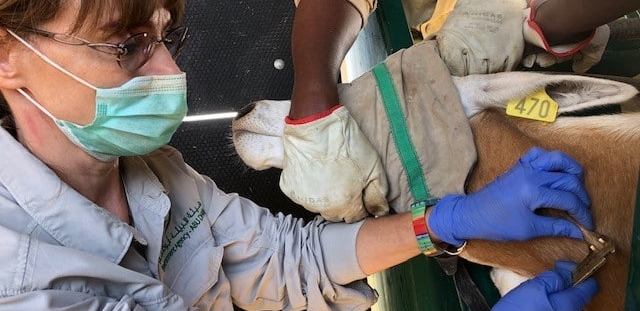Sandscript #30 – Vaccinating antelopes before their reintroduction: a necessity?
Since 2016, the Government of Chad and the Environment Agency – Abu Dhabi (EAD), with the participation of Sahara Conservation, have been translocating scimitar-horned oryx (Oryx dammah), addax (Addax nasomaculatus), and dama gazelles (Nanger Dama) from the United Arab Emirates to Chad, into the Ouadi Rimé-Ouadi Achim Game Reserve. For this project to be a success, preventive medical protocols and treatments had to be set up and applied to the three ungulate species.

Read here the third article of Sandscript 30th issue
During the development of this ground-breaking project some important ethical questions were raised. Including issues such as, should reintroduced animals receive preventive medical procedures? If so, which procedures are appropriate? We also questioned ourselves if we should protect these animals from all possible diseases or if we should allow natural selection to filter out the weaker, less resistant animals.
Considering the significant cost of reintroduction projects, and the high value of each individual animal pushed us to protect all our animals as best we could. Even if we can only protect the first generation of released animals, we can aid the first reintroduced generation to survive the stressful experience with medical aid.
There are many diseases which could compromise the health of our animals, but which ones are the most important?
Wild ungulates are susceptible to many infectious diseases that also affect domestic ungulates and there is very limited data and literature about the role wild ungulates as reservoirs or targets of disease. Our protocols and vaccine selection were based on these publications and institutional experiences.
Since there are not many similar projects of this scale to take inspiration from, we used the experience from the Arabian Oryx (Oryx leucoryx) reintroduction in Saudi Arabia in the 1990s to help set some of our protocols.
The project follows two basic principles:
- Do not harm the existing population of wild and domestic ungulates in Chad by introducing non native diseases. For this we did much intensive pre-translocation screening.
- Protect the first generation of scimitar-horned oryx and addax with vaccines to help them face the harsh adaptation phase when stress is very high, and their immune system is weaker. The surviving animals will be able to produce stronger and more well adapted offspring.
Screening: To ensure the fulfilment of the first principle we needed to produce a healthy herd of candidates for the project. All candidate herds received an annual or biannual general health, Tuberculosis, Brucellosis and Contagious Caprine pleuropneumonia screening. Only animals coming from confirmed negative groups (2 rounds of testing) are eligible for reintroduction.
Vaccination: Vaccination protocols for wild animals should be determined depending on factors specific to species such as susceptibility to a disease or likelihood of encountering different diseases. Other factors to consider are the risks of delivering a vaccine, the distribution/prevalence of a disease in an area, the ability to obtain the vaccine and the percentage success of each vaccine. Additionally, the zoonotic potential of diseases in wild ungulates and the risk of transmission to or from domestic ungulates must be considered.
In the early stages of this project, we met with Chadian veterinary institutions to evaluate which diseases were already present in the area and to verify how prevalent they were.
In our protocol we included core vaccines designed to protect against life threatening, widely spread diseases like the Peste des Petits Ruminants (PPR) and sheep & goat pox, Pasteurella/ Mannheimia/ Clostridium complex. Other vaccines we included were for diseases that are not a severe threat to our animals but that could potentially be transmitted to the local population of farm animals, resulting in enormous economic damages to local farmers. These diseases include Contagious Caprine Pleuropneumonia (CCPP) and Foot and Mouth Disease (FMD).
The initial protocol created was then reviewed and reinforced in 2019, after a Rift Valley fever (RVF) outbreak that killed several scimitar-horned oryx, demonstrating how sensitive these animals were to this virus. We thus introduced a vaccine for RVF in our protocol, together with CCPP vaccine. The current vaccination protocol applied between 2 and 6 months before shipment of animals includes: Multi-strains Pasteurella m./ Mannheimia h./ Clostridium spp., CCPP, FMD, RVF, PPR, Sheep and Goat Pox.
We use vaccines developed for domestic ungulate species, so we don’t know the true effectiveness of these vaccines on our wild animals, but up to now we didn’t record severe side effects and, based on our experience in UAE, they seem capable of protecting all the three ungulate species from all those diseases. In conclusion, setting a preventive medicine protocol requires the consideration of several factors. It is not a static protocol, but it must be adapted accordingly with the results and experiences we gather day by day.
Dr Maria Elena Pesci
Veterinarian
Terrestrial & marine Biodiversity
Environment Agency – Abu Dhabi


